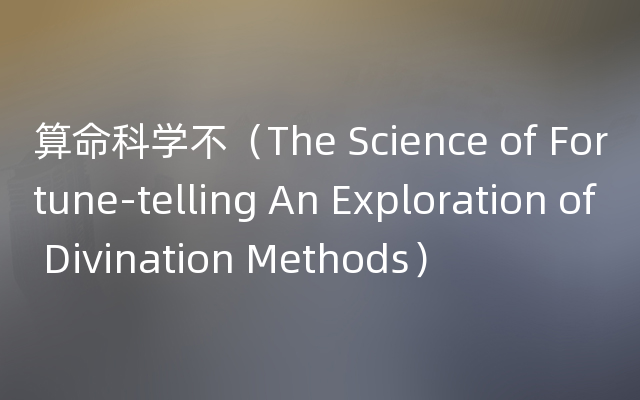
The Science of Fortune-telling: An Exploration of Divination Methods
Divination, the art of predicting future events through supernatural means, has been practiced for thousands of years across cultures and religions. The practice often involves the use of tools such as astrology, tarot cards, and palm reading, among others. Despite being viewed as pseudoscientific by many, it continues to be widely popular in contemporary times. This article aims to provide a comprehensive overview of the most common divination methods, their origins, and their impact on modern society.
Astrology:
Astrology dates back to the Babylonian era, during which celestial events were believed to have a direct influence on human affairs. It is the study of the positions and movements of celestial bodies such as the sun, moon, and planets and their supposed correlation with human behavior and events. Astrologers create charts based on an individual's birth date and time and interpret them to provide guidance and predictions about their future. Despite lacking scientific evidence, astrology remains popular in modern times and has even been integrated into aspects of psychology and counseling.
Tarot:
Tarot cards originated in Europe during the 14th century and were used as playing cards until the late 18th century when occultists started using them for divination. A typical tarot deck consists of 78 cards, each with its unique symbolism and interpretation. Tarot readings involve shuffling and laying out the cards in various patterns, with each card's position and its relationship with other cards influencing the interpretation. While skeptics argue that any interpretations are purely subjective, many continue to find tarot readings insightful and helpful.
Palmistry:
Palm reading, also known as chiromancy, is the art of studying the lines, shapes, and other features of an individual's palms to provide insight into their personality, past experiences, and future events. This practice originated in India and China over 5,000 years ago and has spread worldwide. Palm reading involves examining the lines on the palms, including the heart, head, and life lines, among others, along with the shapes of the hands and fingers. Despite lacking scientific evidence, many individuals find palm readings to be accurate and helpful, and many professional palm readers continue to thrive in contemporary times.
Divination has played a significant role in human history, with many individuals relying on the insights provided by various divination methods to make important life decisions. Although lacking scientific evidence, the popularity of divination practices has continued to increase over time. Still, many critics view them as nothing more than fraudulent practices that prey on the gullibility of believers.
Nonetheless, societies worldwide continue to employ practices such as astrology, tarot readings, and palmistry as mediums of guidance and comfort. They continue to be sought after and trusted, providing insights and predictions to millions of people globally. However, with the exception of a few scientific studies investigating the plausibility of these methods, it is challenging to validate the accuracy and legitimacy of such practices.
In conclusion, divination remains an influential aspect of human culture, regardless of its scientific credibility. Believers of divination methods see it as a way to access information beyond what the physical senses can perceive, and even skeptics acknowledge that there may be some value in the insights offered by these practices. Although there is no conclusive evidence to support the effectiveness of divination techniques, it remains a subject of fascination and inquiry for many individuals worldwide.







